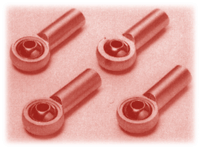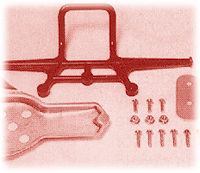Restoration of Tamiya cars
Aluminum parts
These parts are easily identified on a Tamiya car. They are light weight, never have rust on them and a fridge magnet will not stick to them. With the exception of the latest offerings, Tamiya has never anodized their aluminum pieces, so that appear nature: semi-glossy metallic finish.
Restoring these items are pretty easy. There are typically two types of damaged that can be inflicted on an aluminum piece.

The first is physical shock damage. In this type of damage the part has been hit and is either dented or bent out of shape. Because of how software aluminum is, this is not an uncommon problem. Your best solution is to bend or hammer the part back into shape. Determine from either a photo or another part what the original looks like, then gently bend the piece back into the original shape. For "dents" you can try tapping it with a small hammer against a flat surface. I would recommend a block of wood because it is softer, this way a hard blow by a hammer may do less damage.
Sometimes damage to a metal piece can result in a tear. Tears are virtually impossible to fix. You can take a pair of pliers and attempt to bend the part back into shape. Take note though, most aluminum parts tear at stress points such as screw mounting holes. It is very likely that the part will tear again once mounted back on the car. Tears – in the vast majority of cases – will require replacement will a new part.

The second is surface abrasion or oxidation. This type of damage is very common for those aluminum parts that fit on the underside of a vehicle (e.g. the chassis plate on the front of a Tamiya Frog frame). This type of damage can be cleaned up with steel wool and some elbow grease. Use a fine grade of steel wool and gentle polish the aluminum in only one direction. This will give you a better result than rubbing in circles.
For those areas of the part that are hard to reach (such as crevices and inside corners), I’ve found that tearing a small piece of steel wool and placing it on the tip of an old ball point pen can do wonders. Ensure that you have an adequate amount of steel wool padding the tip so that it doesn’t do more damage to your piece.
Some readers have recommended chemical dips such as "Aluminum Brightener" for getting rid of oxidation. I'm sure the stuff works, but the acidic nature of the chemical and the rarity of it makes it tough to recommend this option.
